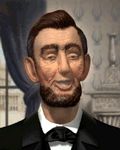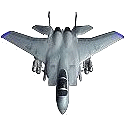The Americans |
||||||||||||||||||||||||||||
| Profile | ||||||||||||||||||||||||||||
|
||||||||||||||||||||||||||||
|
American Cities
Great Leaders
|
Background
The United States is relatively young by Civilization standards, being barely more than 200 years old; it achieved its current size and influence only in the mid-20th century. America was the first of the European colonies to separate successfully from its motherland, and it was the first nation to be established on the premise that sovereignty rests with its citizens and not with the government. In its first century and a half, the country was mainly preoccupied with its own territorial exploration and expansion and with economic growth. American politics became increasingly democratic during the 1820s and ’30s. But a matter of freedom would bring the nation to its greatest crisis: the American Civil War. On February 4, 1861 – a month before Abraham Lincoln (1860-1865) could be inaugurated in Washington – six Southern states sent representatives to Montgomery to declare a new independent government. With Jefferson Davis at its head, the Confederate States of America came into being, set up its own bureaus and offices, occupied federal buildings, issued its own money, raised its own taxes, and flew its own flag. With the Union preserved, the nation entered a period of unprecedented prosperity after the long conflict and reconstruction. In the ensuing two decades industrial production, the number of industrial workers, and the number of factories all more than doubled. European immigration, westward expansion, urban growth, technological advances and a host of American inventions – including the telephone, typewriter, linotype, phonograph, electric light, cash register, air brake, refrigerator car, and the automobile – contributed to the American explosion, while widespread use of corporate organization offered new opportunities for large-scale financing of business enterprise and attracted new capital. Militarily speaking, the Spanish-American War of 1898 was so brief and relatively bloodless as to have been a mere passing episode in the history of modern warfare but it catapulted the United States into the arena of world. Before the 1890s, roughly speaking, most Americans had stubbornly adhered to the belief, as old as the Revolution itself, that their country should remain aloof from European affairs and offer an example of democracy and peace to the rest of the world. But the United States had become a great power by virtue of its prodigious economic growth since the Civil War; now many thought it ought to begin to act like one. In World War I, and again in World War II, American industrial might and military technology proved decisive. However, the debacle of Vietnam, set in the morass of the Cold War, shook America’s belief in its “victory culture” and “manifest destiny,” a malaise that would not pass for 20 years. Lasting but 40 days, the Gulf War was easily won by the U.S.-led coalition at only slight material and human cost, but its sophisticated weapons – spearheaded by the American F-15 fighters – caused heavy damage to Iraq’s military and economic infrastructure. With the declining power (and subsequent collapse in 1991) of the Soviet Union, the war also emphasized the role of the United States as the world’s single superpower at the beginning of the 21st century, its culture and technology spreading around the globe. Unique Unit: the F-15 The F-15 is an upgraded version of the standard jet fighter. Both require oil and aluminum to build, but the F-15 has a more powerful bombard strength and twice the rate of fire, making it a much more powerful unit for bombing runs.
|
|||||||||||||||||||||||||||

 The Americans are expansionist and industrious. They start the game with Pottery and Masonry and build F-15s instead of normal jet fighters.
The Americans are expansionist and industrious. They start the game with Pottery and Masonry and build F-15s instead of normal jet fighters.  The successor to the Grumman F-14 Tomcat, the F-15 was the first military aircraft with a genuine "look-down/shoot-down" capability, the product of pulse-Doppler radars that could detect fast-moving targets against cluttered radar reflections from the ground. Also designated the Eagle, the American F-15 was a twin-engine jet fighter produced by the McDonnell Douglas Corporation. Based on a design proposed in 1969 for an air-superiority fighter, it has also been extensively used in fighter-bomber versions. For two decades, it was the primary fighter of the American Air Force. F-15s were delivered to the U.S. Air Force between 1974 and 1994, and since have been sold to American allies and assembled under contract in Japan. The "Strike" Eagle carried out much of the nighttime precision bombing of Iraqi installations during the Persian Gulf conflict (1990-1991), as well as sweeping the Iraqi Air Force from the skies.
The successor to the Grumman F-14 Tomcat, the F-15 was the first military aircraft with a genuine "look-down/shoot-down" capability, the product of pulse-Doppler radars that could detect fast-moving targets against cluttered radar reflections from the ground. Also designated the Eagle, the American F-15 was a twin-engine jet fighter produced by the McDonnell Douglas Corporation. Based on a design proposed in 1969 for an air-superiority fighter, it has also been extensively used in fighter-bomber versions. For two decades, it was the primary fighter of the American Air Force. F-15s were delivered to the U.S. Air Force between 1974 and 1994, and since have been sold to American allies and assembled under contract in Japan. The "Strike" Eagle carried out much of the nighttime precision bombing of Iraqi installations during the Persian Gulf conflict (1990-1991), as well as sweeping the Iraqi Air Force from the skies.